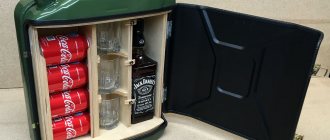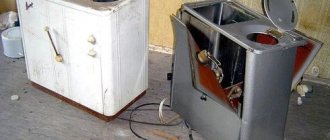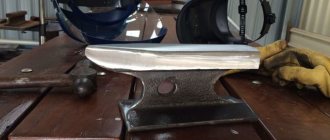The expansion tank compensates for the increase in the volume of heated coolant, reducing the pressure in the wiring. Therefore, such a unit must be present in both open and closed heating systems. Moreover, you can even make a tank for a closed system with your own hands, using homemade or ready-made containers.
In most cases, the coolant compensator is mounted between the pressure fitting or pipe of the boiler and the first battery. With this location, an open-type expansion tank replaces a safety valve - if the boiler overheats, the steam will not go into the system, but will escape out, directly into the atmosphere.
In multi-storey buildings, the expansion tank is mounted in the attic area or under the ceiling of the boiler room
But for this to happen, the tank must be designed as the highest point of the system, raised above the boiler, above the batteries, and above the wiring. To do this, at the point where the vertical branch of the pressure pipeline meets the horizontal section, a tee is installed, to the upper branch of which a piece of fittings connecting the system and the tank is attached.
Therefore, in multi-storey buildings, expanders are installed in the attic area. Or under the ceiling in the boiler room, if, of course, the dimensions and volume of the tank allow it. Therefore, before assembly, we need to try to calculate the geometry of the container, starting from the recommended volume.
The dimensions of the expansion tank for an open-type heating system are calculated based on the volume and temperature of the coolant. Moreover, the simplest formula operates only on the first parameter. In this case, the volume of the tank is equal to five percent of the same system parameter.
For example, if 200 liters of water are poured into the wiring, boiler and batteries, then the volume of the expansion tank is 10 liters (200×5%).
A more accurate and complex formula operates not only on the capacity of the system, but also on the temperature of the coolant. After all, heating by 10 degrees Celsius scales the volume by 0.3 percent. And since the initial water temperature is equal to room temperature (20 °C), and the maximum heating temperature reaches only 100 °C, then scaling the volume of liquid poured into the system is only possible up to 2.4% (((100-20)/10)× 0.3).
That is, if the same 200 liters are poured into the wiring, then the volume of the tank according to the refined formula will not exceed 4.8 liters (200 × 2.4%).
In practice, it is better to use either a larger value calculated using a 5% proportion, or an average result, which is determined based on half the sum of 5% and 2.4% of the coolant volume. And for a 200-liter system, the average volume is 7.4 liters ((10+4.8)/2).
Now that we know the method for calculating the tank capacity, we can move on to the technology for assembling the product itself.
A rare heating system will hold more than 200-300 liters of coolant, therefore, the volume of our tank will be 10-15 liters. To make such a tank we need a sheet of metal with dimensions of 50x75 centimeters. The thickness of the sheet can be arbitrary, but the 2-mm option is considered optimal.
A sheet metal tank can only be assembled by an experienced welder.
Well, the assembly process itself looks like this:
- Using a grinder, we cut the sheet into two pieces 25×75 centimeters.
- Using a grinder, we cut these strips into six pieces of 25x25 centimeters.
- We burn a hole in one workpiece with a cutter or electrode and weld a fitting with a 1.0 or ½ inch threaded tap in this place.
- We weld two workpieces at right angles to each other. We proceed in the same way with two more blanks. Next, we assemble a cube without a bottom and a lid, connecting these corners by welding.
- We weld the seams until they are sealed. We test joints with chalk and kerosene.
To check the tightness of the seam, apply chalk from the outside, kerosene from the inside. If after some time no greasy spots appear on the chalk strip, the seam is welded hermetically.
- We weld the bottom to the cube - a blank with a welded pipe. Check the seams for leaks.
- Using a cutter or arc from the electrode, we burn a 5x5 centimeter hole in the last workpiece.
- We weld the workpiece with a hole on the side of the cube lid. In this case, it is not necessary to check the tightness of the seams.
As a result, we get a capacity of 15.6 liters (25 × 25 × 25 = 15625 cm3 = 15.625 l). Moreover, during the assembly process we consume metal without a trace, and the total capacity of such a tank is enough for a 300-liter system.
The only drawback of this option is the significant complexity of the process. Only an experienced welder can assemble such a tank. And if you do not know how to weld hermetic seams, then it is better for you to turn to another type of metal structures, for example, a tank based on a ready-made container - a cylinder.
All and a little more about gas tanks for motorboats
A continuous supply of fuel for the movement of a motor boat is provided by the gas tank for the outboard motor, which is an integral part of the fuel system.
They come in different types and configurations, and also vary in volume. This article will tell you more about this and whether it is possible to make a fuel tank with your own hands.
DIY car gas tank repair
Installing a plastic patch using a soldering gun and special hot glue.
Drain the gas tank and wash it inside and out with soapy water. Lightly sand the perimeter of the area to be repaired.
Cut a piece of plastic larger than the hole, made from gas tank-like material, slightly larger than the repair hole.
Heat up the electric soldering gun, apply your patch and completely go over the contour of the cut plastic with a soldering gun with special hot glue, check that the glue completely covers the edges of the patch and is well sealed to the plastic of the tank itself.
You can also additionally apply epoxy resin or solvent-resistant glue along the contour for greater reliability of the weld.
Design and types of fuel tank for a motor boat
A standard fuel tank for outboard motors usually consists of several components, namely:
This equipment is inherent in all types of gas tanks. The fuel is poured into a container, which is closed with a special lid equipped with a vent valve or fitting. This is due to the fact that when exposed to sunlight and elevated temperatures, the gasoline in the tank begins to evaporate and its vapors create excess pressure, which poses a danger of ignition of gasoline vapors. Excess pressure is released using a device mounted in the gas tank cap.
Using a connecting hose, fuel is supplied from the tank directly to the outboard motor. The volume of the tank is determined based on the power of the motor installed on the boat.
Varieties and classification
There is a division of tanks for outboard motors according to design features into the following categories:
- built-in: non-removable tanks that are installed on motors up to 6 horsepower of small boats; they are mounted directly under the protective cover of the motor;
- removable or portable: used on inflatable boats and small boats, this type is preferred by fishermen and tourists traveling long distances;
- stationary: such tanks are installed on more powerful engines, they have a larger capacity and are used on large boats and yachts.
There is also a division of gas tanks into soft and hard.
Soft fuel tanks are made from special impermeable materials with increased elasticity, ensuring the tightness of the tank container. When the tank is filled, they stretch, and as gasoline is used, their size decreases. The advantage of this type of gas tank is the fact that gasoline vapors do not accumulate in them. Small dimensions and the ability to change shape allow them to be installed in places where a conventional rigid tank simply will not fit. The main disadvantage of such a tank for a motor boat is its high price.
As for the shape of the fuel tank, they are usually made either in the form of a canister or as a rectangular tank.
Based on the material used, gas tanks are divided into the following types:
All materials must be petrol resistant. Fabric (soft) gas tanks are made from multi-layer polymer fabrics that provide the containers with tightness and chemical resistance to the aggressive effects of gasoline.
Features of choice
The volume of the fuel tank is determined based on the power of the outboard motor installed on the boat. Very often, people who make long trips on motor boats (fishermen, tourists) are faced with the question of increasing the capacity of the gas tank.
There are several options to solve the problem. You can install an additional fuel tank of greater capacity, take with you a supply of gasoline in cans, etc. But such a solution to the problem implies an irrational use of free space, of which there is already little on a boat or boat.
The best option is to install an additional gas tank on the transom of the boat; this saves space and prevents the tank from moving on the wave. On inflatable boats, such a tank is mounted on a suspended transom, on PVC boats - on a stationary one, and on boats and rigid boats - on the stern. Some craftsmen install several flat containers connected to each other by tubes under the flooring on the bottom.
It should be remembered that when choosing a fuel tank, you need to pay attention to the following points:
- equipment (all fittings and fasteners must correspond to the equipment declared by the manufacturer);
- quality of the material (the tank container must be sealed, resistant to gasoline vapors, durable and resistant to temperature changes);
- The bottom of the gas tank must be equipped with compartments to collect condensate to prevent water from entering the gas line.
Fuel tanks made of various types of plastics and flexible fuel tanks are becoming increasingly popular, despite their higher cost.
How to make a gas tank yourself?
Experienced fishermen and tourists, who have extensive experience in finishing and altering equipment in accordance with their needs, make gas tanks with their own hands. Various containers and reservoirs are used. There is a lot of useful information on the forums on how to make a gas tank yourself.
A fitting for adjusting the pressure, equipped with a valve, is cut into a regular canister, as well as a gas-resistant hose, mostly transparent, for supplying gasoline to the outboard motor.
In addition to canister tanks and containers of various kinds, they also remake car fuel tanks with their own hands for installation on a motor boat. And they even manage to install a fuel level monitoring system, also taken from a car. Anyone can learn from experience and make a gas tank with their own hands that meets their personal needs.
Fuel level control systems
An important point is the need to control the level of gasoline in the fuel tank, because... When traveling by water, there will be nowhere to refuel. There are various methods for controlling the amount of fuel, for example:
- visually – there are marks on the plastic tank and the gasoline level is visible;
- using a fuel level monitoring system.
Level sensors are mechanical and electronic. By analogy with automobile systems, boats are equipped with special fuel level monitoring systems that display data on the fullness of the gas tank on its lid or on the dashboard of the boat.
Updating the motorcycle: airbrushing the motorcycle tank
Regular motorcycle painting has a number of features, but this applies to painting any surfaces. For example, if you want to create some kind of image on the surface, the process will become more complicated. After all, such manipulations will require artistic skills, although you can paint a motorcycle without them. Here you will only need the necessary materials, with which ones - read below.
Communities › Boats and Motors › Blog › Fuel tank for PLM from a metal canister.
The canister was purchased at Yulmart, capacity 10 liters. I ordered connectors, fittings, a hose with a bulb in 1000 sizes. There are plans to add a level sensor, there are already ideas.
Comments 17
10 liters won't be enough? In my practice, it happens 12-15 liters in both directions, engine 9.5
Fine! My transitions are small.
It's clear! well done and neat! I am currently preparing a 24 liter tank from aluminum. I measured that on a glider, 500 grams per kilometer are consumed at a speed of 28-33 km/h, depending on the current if it is a river. But when well loaded, it’s 8-12 km at full throttle, and the consumption is 2 liters per 1 km! There is no infection on the glider) And sometimes you have to swim 15 km in one direction, our lake is large and spilling!
I rarely get more than 10 km during my entire fishing trip.
Now I’ll get around to it, I’ll put in an email. I hope the ignition consumption will decrease! I already bought the kit) The season closed yesterday for the rides) In the winter I’ll be picking out the plm!
I also plan to install an EZ. The circuit has already been tested on Rusfish, all that remains is to repeat it.
Do they write about consumption? Any improvements?
The engine's consumption is minimal, so it's difficult to judge. It takes time, but the blocks have only just been made. But they write about more stable operation of the engine. Most likely, consumption should decrease. If interested, check out www.rusfishing.ru/forum/s...?p=7906083&postcount=5071
Thank you! I'll take a look! Yes, they say that it will even start better! Well, I can judge by my UAZ, when I had the original engine installed, I installed the BZ and the engine even began to run quieter! And pick up speed sharply, and the consumption dropped a little!
Recommendations
Comments 28
I want the same...what did I miss...at least I would suggest that it fit into the topic)
Well, you know all the logins and passwords
Did the guys make it themselves or order it from somewhere?
by eye - 55-60 liters
Hello ! check your eyesight))))) 120-140 l
I wrote on 1 eye, but there is also a second one! then you will get the displacement you expect
Hello, usually this is 0.7-1 liters, if you take a larger quantity, marmots or other animals may come, they say proteins are now in short supply and there is not enough for everyone. I agree completely - from the photo only by eye, with respect
Eco there, everything is rotting in your capitals)))
The climate of the city, but it’s not clear what they’re covering the roads with)
Why are you driving it around Moscow?))
San, I haven’t seen him for a long time
Come on, I recently rode chicks)))
Eco there, everything is rotting in your capitals)))
Hello . If after the ride you don’t or are too lazy to wash off all possible accumulations of dirt on the body, then don’t worry too much - you’ll quickly outstrip us. and after such repairs, we are ready to lose this competition in rust to anyone and anytime, and if we don’t get any prizes in this competition, I will consider it an honor. because only an idiot can be worse than this bastard. And if they take on the car together, the car simply has no chance.
I don’t understand a damn thing about your competition there)))
You wrote about the Kruzak that in the warm weather it also began to participate in these competitions and you are trying to remove it from the race by parking it on the street. How about a nurse for a friend? Haven't you looked under the kung?
The nurse there has a different design and there is nothing there to rot. The kung itself is plastic
but still take a look. Kung himself cannot live independently. especially plastic. I could be wrong, but the kung is placed on a 712t base and there the iron bottom is the same as everyone else’s
Yes, I specifically tried to find the same places where yours is rotting there and did not find it, although I looked without a hole from the outside. It seems to me that the design is made differently there.
you have a note in your blog about BarobanoFF2013, everything is visible there. It’s precisely those same floor enhancers that have given us headaches. It was precisely about the technological holes in them that I wrote. second photo - take a closer look. It just turns out that the water comes in and goes out, but the silt remains - you’re not walking on clean water.
Exhaust pipe with cooling. Tank ventilation head. The engine is powered by two gas tanks.
Exhaust pipe with cooling.
You can avoid thermal insulation of the exhaust pipe if you cool it with water injected from the engine cooling system.
Water is injected at a distance of 0.5-0.6 m from the flange of the exhaust manifold 1 of the engine (Fig. 198) after the exhaust pipe 4 is slightly bent upward, which prevents water from entering the engine when idling at low speeds.
Cooling water from the manifold jacket is introduced through tube 3 into the exhaust pipe in one of two ways shown in the figure. Supplying water through a cylindrical water jacket 6, which has 20-25 holes with a diameter of 2 mm, better atomizes and cools the exhaust gases. Pipe section 2 is insulated with asbestos before water is introduced; then the pipe can even be made of rubber (durite) hose 5.
Injecting water into the exhaust pipe also reduces noise, especially on two-stroke engines.
Kingston filter.
The water intake of the engine cooling system and the filter can be combined in one device
(Fig. 199) .
Housing 2 has a flange at one end for fastening to the casing, and at the other - a thread for cover 4. A thin-walled tube is inserted inside, into which holes with a diameter of 2.5-3 mm are drilled. The number of holes and the length of this filter tube 3 are easy to calculate: the total area of the holes should be 1.5-2 times greater than the area of the hole in the pipe 6. Instead of a tube, you can use a metal mesh with a corresponding cell.
Valve 5 is installed on the pipe; The hole in pillow 1 must be made smaller than the diameter of filter 3.
Tank ventilation head.
To reliably protect the gas tank from water ingress, a deck head is placed at the outlet of the air tube (it can also be installed on vertical walls).
Housing 6 (Fig. 200) with an air tube 7 inserted into it from the gas tank is attached to deck 3 with a nut 5 with gaskets 4.
One central (pos. a) and four external (pos. b) air holes are drilled in the body, closed with a package 2 of six to eight layers of thin copper mesh, pressed with a mushroom-shaped cap 1 on the thread. The mesh pack protects the device from sparks and water.
Additional gas tanks for Kazanka.
Gas tanks shown in
Fig. 201 , are conveniently placed between the first and second (counting from the transom) frames along the sides of the Kazanka.
The capacity of each tank is 35 l; they can be welded from 1.5mm thick aluminum alloy sheets or made from galvanized iron roofing. The tank is bent from one sheet of 750x890 mm in such a way as to create one longitudinal seam located on the top side. All connection locks on iron tanks must be soldered and their tightness checked.
The filler plug is used to secure the intake tube and place the air hole.
Gas tank for Progress.
Under the front seat of the Progress it is advisable to place a permanent gas tank with a capacity of up to 100 liters
(Fig. 202). To prevent fuel from overflowing from one side to the other when heeling (the boat may end up with a dangerous heel as a result), the gas tank is divided by several baffle partitions 3. Small holes must be made in the corners of these partitions so that the fuel flows to the intake tube 4. Air tube 2 is better bring up and onto the deck of the boat; Plug 1 can be taken from a standard outboard motor tank.
How to patch a plastic gas tank
Method one - patch the gas tank with epoxy glue
Drain the gasoline from the tank and let it dry. Sand the area around the hole or crack and wipe it down with an alcohol-soaked rag.
Mix 2 parts epoxy resin and apply around the entire perimeter of the hole. Cut the fiberglass patch wide enough to cover the hole and seal it off.
Place a fiberglass patch over the entire diameter of the hole and press the epoxy resin to cover the fiberglass. Apply more epoxy to the area and apply your patch, press down with something and let dry.
After drying, you can carefully clean it and apply paint to match the color of the tank.











